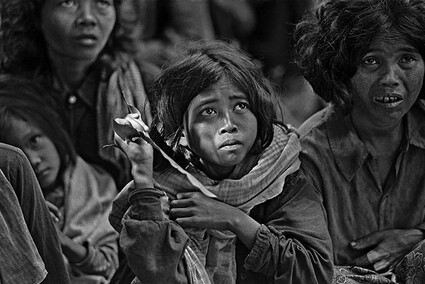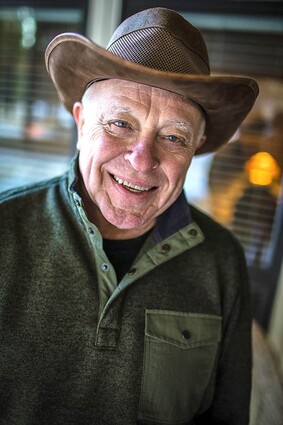Sisters photographer honored
Last updated 8/7/2019 at Noon

Jay Mather
Jay Mather’s Pulitzer Prize-winning photographs from Cambodian refugee camps in 1979 will be shown at an international photojournalism festival. w
Sisters photographer Jay Mather is being recognized for his work in Cambodia during a time when the country was in turmoil. His work will be featured in the Visa Pour l´Image International Festival of Photojournalism near Paris in September.
Mather visited the country in 1979 when the communist Khmer Rouge regime had slaughtered 1.7 million people — 21-24 percent of Cambodia’s population.
Mather and reporter Joel Brinkley went on the lines of the refugee camps reporting and photographing the crisis in the surrounding areas. The Louisville (Kentucky) Courier sent Mather and Brinkley alongside doctors to document the brutality inflicted upon the Cambodian people, as well as treat the sick and starving refugees.
Mather heard of the chaos happening after seeing a CBS special report on one Dr. Ken Rasmussen, a Louisville physician at the time who went to Cambodia looking after the refugees. CBS had done a report on what he had been doing and seeing while there. Mather approached editors to get support for following up on the story.
At the time, the Louisville Courier was an “aggressive news-gathering organization, and with this project we became the ‘blue engine that could,’ due to the scale and aspects of the story,” Mather told The Nugget.
Bill Cox, the city editor at the time, was instrumental in getting the project off the ground and sent Mather and Brinkley to the Cambodian border on a three-week-long journey into the war-torn Cambodian, Vietnam and Thai borders.
The report earned the Louisville Courier a Pulitzer Prize in 1979.
Mather and his reporting partner were on the border of Cambodia and Thailand for three weeks photographing and writing about the refugees in the camps. The effect on Mather was a lifelong one.
“After a few months of being back from it, I finally stopped having dreams about it,” said Mather.
The refugees in the camp were a mix of those who were affected by the genocide as well as soldiers of the Khmer Rouge who were also starving and malnourished.
“The feelings at the camps were very tense because everyone knew who was who and no one knew what was going to happen to them at night,” he said.
The effect of seeing people in these states had a profound effect on Mather, which he had to set aside to do his job.
He explained, “the camera acts as a great shield because it allows you to be in a situation and not super emotionally involved; you are sort of removing yourself. When you are there in that situation, you are not in a position to help these people necessarily, you are there to show what is going on,” said Mather.
Mather explained that he and Brinkley talked about how much they wish they could know what happened to some of the people they connected with and interacted with. But there would be no way of knowing what happened to the people they had met. Toward the end of their journey, they did find a family who had escaped the area and had a sponsor in the United States, who happened to be Dr. Ken Rasmussen.
“They had their own story to tell about their escape, and it had come full circle with their sponsor being Rasmussen,” said Mather.
The Khmer Rouge regime eventually collapsed, laying down their arms in 1999 and a constitutional monarch was put into place in 2004.
Mather and Brinkley returned to Cambodia in 2009 after the 30th anniversary of the genocide. Brinkley was writing a book entitled “Cambodia’s Curse” and asked Mather to go back with him and photograph for the book.
“His book contained detailed and extensive information on the effects on the population and the corruption the country faced,” said Mather.
Brinkley died a few years ago from an aggressive form of leukemia. Brinkley’s syndicated column was often featured in The Nugget, and his work in Cambodia will be remembered.
“I wish Joel could be with me on this,” said Mather of the festival showing.
This year being the 40th anniversary of the 1979 events, Mather decided to break out the old negatives and scans and prints of the Cambodian work. He submitted it to the French photojournalism festival Visa Pour l´Image near Paris. Mather wanted to submit his pieces 40 years later because he believes in breaking old work out of the boxes.
“If you don’t share the work, what is the point of doing it?” he said.
Mather submitted his work at the beginning of the year, but did not hear back until mid-July. And what he heard back was that he had been selected for a screening of his work at the photojournalism festival in September. Mather and his wife, Diane, are planning on making a vacation out of the visit to France for the screening.
The festival contains a number of exhibits about events in the world, including images of the Iranian revolution, which also occurred 40 years ago. The organization focuses on showing images and videos that have to do with planet and humanitarian issues faced in the last year — but it also does these special retrospectives, and Mather’s collection of photos was chosen.
He submitted 110 images from his collection of film photos. There is a combination at the festival of large hung prints, as well as film screenings of photos. Mather’s work is being shown in a 20-minute screening that opens with the CBS report on Dr. Rasmussen’s work as a way to provide context to the situation.

Jay Mather
Jay Mather can still be found, camera in hand, on the landscape of Sisters Country, which he has called home for many years. w
The video contains numerous images of refugees and children in the camps where they were placed, looking starved, homeless and scared.
“I am glad that someone can go and honor the work and the people,” he said.
Mather since has donated some of the images from Cambodia, as well as others scans, to the Louisville University photographic archive. They will also be doing an exhibit of his work in October.
“I think that photos shouldn’t sit in a garage, and thought that they should be in a place where they are protected and taken care of,” he said.
Mather believes that sharing his work, even so many years later, is to honor the people affected as well as honor the work and effort put out for the story.
“It is not about me, but the work being honored,” he said.

















Reader Comments(0)